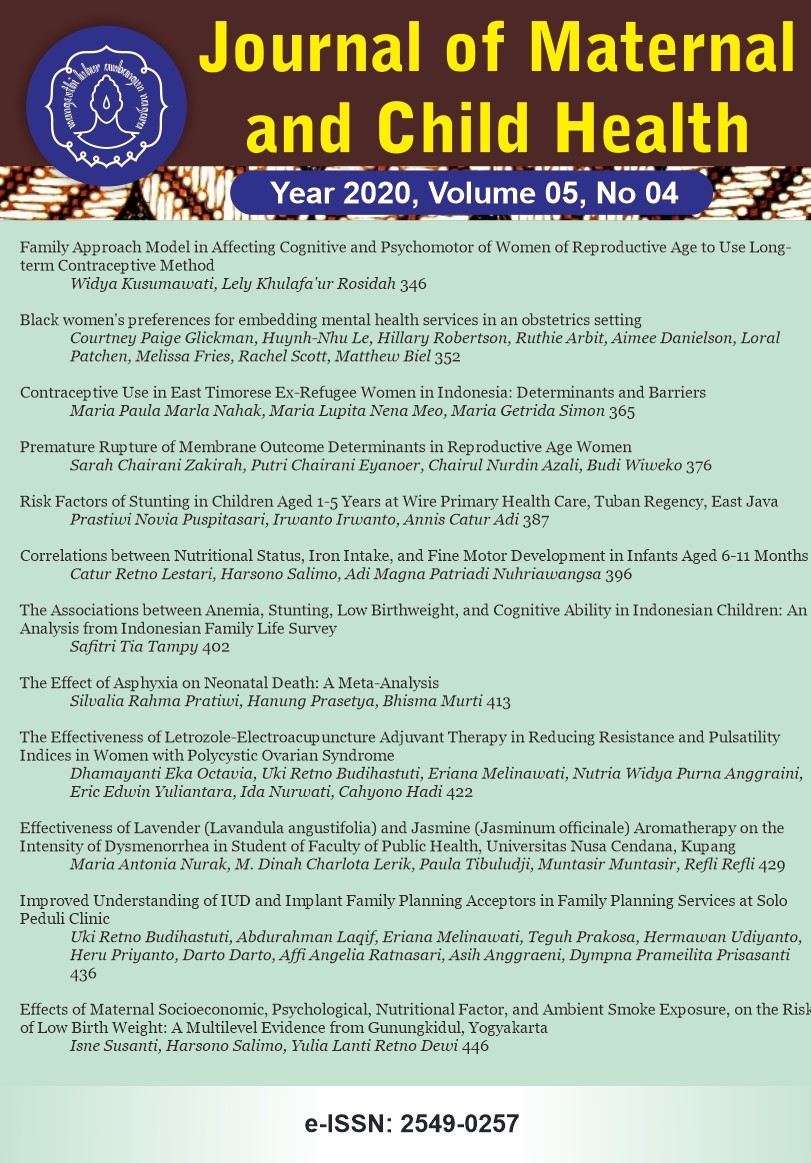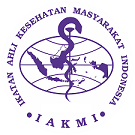The Associations between Anemia, Stunting, Low Birthweight, and Cognitive Ability in Indonesian Children: An Analysis from Indonesian Family Life Survey
Abstract
Background:
How to Cite
References
Alamy M, Bengelloun WA (2012). Malnutrition and brain development: An analysis of the effects of inadequate diet during different stages of life in rat. Neurosci Biobehav Rev, 36(6), 1463
Allali S, Brousse V, Sacri AS, Chalumeau M, Montalembert M (2017). Anemia in children: prevalence, causes, diagnostic work-up, and long-term consequences. Expert Rev Hematol, 10(11): 1023
Arafah N, Lubis M, Fujiati II (2019). Stunting and anemia are associated with cognitive abilities in primary school children. Glob J Res Anal, 8(10), 16
Badan Penelitian dan Pengembangan Kesehatan RI Kementrian Kesehatan. (2013). Riset Kesehatan Dasar 2013. Retrieved from https://www.kemkes.go.id/-resources/download/general/Hasil Riskesdas 2013.pdf
Badan Penelitian dan Pengembangan Kesehatan RI Kementrian Kesehatan. (2018). Hasil Utama Riset Kesehata Dasar (RISKESDAS) 2018. Retrieved from http://kesmas.kemkes.go.id/assets/upl
oad/dir_519d41d8cd98f00/files/Hasil-riskesdas-2018_1274.pdf
Beal TY, Tumilowicz A, Sutrisna A, Izwardy D, Neufeld LM (2018). A review of child stunting determinants in Indonesia, Matern Child Nutr 14(4), 1
Danaei G, Andrews KG, Sudfeld CR, Fink G, McCoy DC, Peet E, Sania A, Fawzi MCS, Ezzati M, Fawzi WW (2016). Risk factors for childhood stunting in 137 developing countries: A comparative risk assessment analysis at global, regional, and country levels. PLoS Medicine, 13(11), 1
Departemen Kesehatan RI (2009). Pedoman pelaksanaan stimulasi. deteksi dan intervensi dini tumbuh kembang anak di tingkat pelayanan kesehatan dasar. Depkes RI.
Fajariyah RN, Hidajah AC (2020). Correlation between immunization status and mother
Gebreweld A, Ali N, Ali R, Fisha T (2019). Prevalence of anemia and its associated factors among children under five years of age attending at Guguftu health center, South Wollo, Northeast Ethiopia. PLoS ONE, 14(7), 1
Ikatan Dokter Anak Indonesia. (2016). Anemia Kekurangan Zat Besi. Retrieved from https://-www.idai.or.id/artikel/seputar-kesehatan-anak/anemia-kekurangan-zat-besi
Junaidi (2015). Model regresi binary logit (Aplikasi Model dengan Program SPSS). June. https://doi.org/10.13140/RG.2.1.1580.0481
Kim HS, Kim EK, Park HK, Ahn DH, Kim MJ, Lee HJ (2020). Cognitive outcomes of children with very low birth weight at 3 to 5 years of age. J Korean Med Sci, 35(1): 1
Larson LM, Phiri KS, Pasricha SR (2017). Iron and cognitive development: What is the evidence?. Annals of Nutrition and Metabolism, 71(3): 25
Leroy J (2011). ZSCORE06: Stata module to calculate anthropometric z-scores using the 2006 WHO child growth standards Statistical Software Components S457279 (revised 04 Oct 2011). Boston College Department of Economics.
L
McKee SG, Close R, Lowenthal E (2017). Evaluation of iron deficiency anemia in a pediatric clinic in the dominican republic. Annals of Global Health, 83(3
Menteri Kesehatan Republik Indonesia. (2020). Peraturan Menteri Kesehatan Republik Indonesia Nomor 2 Tahun 2020 tentang Standar Antropometri Anak.
Muhoozi GKM, Atukunda P, Mwadime R, Iversen PO, Westerberg AV (2016). Nutritional and developmental status among 6- to 8-month-old children in southwestern Uganda: A cross-sectional study. Food Nutr Res, 60. https://doi.org/10.3402/fnr.v60.30270
Ni
Oluwole OB, Noll RB, Winger DG, Akinyanju O, Novelli EM (2016). Cognitive functioning in children from Nigeria with sickle cell anemia. 63(11), 1990
Pasaribu EO (2019). Analisis determinan gizi lebih dan kaitannya dengan fungsi kognitif anak di Indonesia. Institut Pertanian Bogor.
Permatasari D (2019). Hubungan berat bayi lahir rendah dengan kejadian stunting pada bayi usia 0
24.004
Rachmi CN, Agho KE, Li M, Baur LA (2016). Stunting, underweight and overweight in children aged 2.0-4.9 years in Indonesia: Prevalence trends and associated risk factors. PLoS ONE, 11(5), 1
154756
Rahmadi A (2016). Hubungan berat badan dan panjang badan lahir dengan kejadian stunting anak 12-59 bulan di Provinsi Lampung. Jurnal Keperawatan, Volume XII(ISSN 1907-0357), 209
Rahmadini A (2020). Litteratur review: Hubungan stunting dengan perkembangan motorik dan kognitif anak. Prosiding Seminar Nasional Kesehatan
Rand Corporation. (2014). The Indonesian Family Life Survey (IFLS) Santa Monica, Califonia: Rand Corporation; 2014. Retrieved from http://www.rand.org/labor/FLS/IFLS.html.
Stewart CP, Iannotti L, Dewey KG, Michaelsen KF, Onyango AW (2013). Contextualising complementary feeding in a broader framework for stunting prevention. Maternal and Child Nutrition, 9(S2), 27
Sujianti (2018). Hubungan usia ibu dengan kejadian Bayi Berat Lahir Rendah (BBLR) di RSUD Cilacap. Kesehatan Al-Irsyad, XI(1), 62
Tim Nasional Percepatan Penanggulangan Kemiskinan. (2017). 100 Kabupaten/Kota Prioritas untuk Intervensi Anak Kerdil (Stunting). Sekretariat Wakil Presiden Republik Indonesia.
Upadhyay RP, Naik G, Choudhary TS, Chowdhury R, Taneja S, Bhandari N, Martines JC, Bahl R, Bhan MK (2019). Cognitive and motor outcomes in children born low birth weight: A systematic review and meta-analysis of studies from South Asia. BMC Pediatrics, 19(1), 1
World Health Organization (2009). WHO child growth standards and the identification of severe acute malnutrition in infants and children. Retrieved from http://apps.who.int/iris/bitstream/106
65/44129/1/9789241598163_ eng.pdf
World Health Organization (2011). Haemoglobin concentrations for the diagnosis of anaemia and assessment of severity. In Vitamin and Mineral Nutrition Information System. Geneva, Switzerland: World Health Organization. Retrieved from http://www.who.int/vmnis/-indicators/haemoglobin. pdf










